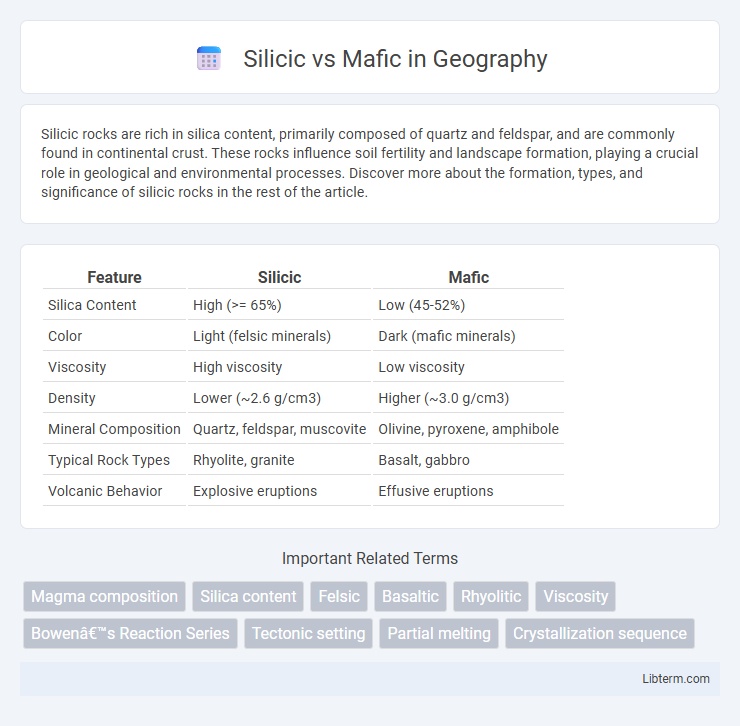Silicic rocks are rich in silica content, primarily composed of quartz and feldspar, and are commonly found in continental crust. These rocks influence soil fertility and landscape formation, playing a crucial role in geological and environmental processes. Discover more about the formation, types, and significance of silicic rocks in the rest of the article.
Table of Comparison
| Feature | Silicic | Mafic |
|---|---|---|
| Silica Content | High (>= 65%) | Low (45-52%) |
| Color | Light (felsic minerals) | Dark (mafic minerals) |
| Viscosity | High viscosity | Low viscosity |
| Density | Lower (~2.6 g/cm3) | Higher (~3.0 g/cm3) |
| Mineral Composition | Quartz, feldspar, muscovite | Olivine, pyroxene, amphibole |
| Typical Rock Types | Rhyolite, granite | Basalt, gabbro |
| Volcanic Behavior | Explosive eruptions | Effusive eruptions |
Introduction to Silicic and Mafic Rocks
Silicic rocks are rich in silica, typically containing over 65% silica content, and are often light-colored with minerals like quartz and feldspar. Mafic rocks contain lower silica content, usually between 45-52%, and are characterized by dark-colored minerals such as pyroxene and olivine. These compositional differences influence their density, melting points, and geological formation processes.
Chemical Composition Differences
Silicic rocks contain high silica content, typically over 65%, with abundant quartz and feldspar minerals, leading to lighter coloration and lower density. Mafic rocks have lower silica content, around 45-55%, and are rich in iron, magnesium, and calcium-bearing minerals such as pyroxene and olivine, resulting in darker, denser rock. These chemical composition differences influence crystallization temperatures, magma viscosity, and tectonic settings of formation.
Formation Processes
Silicic rocks form through the slow cooling and crystallization of silica-rich magma, typically in continental crust environments where partial melting of felsic minerals occurs. Mafic rocks originate from the rapid cooling of magnesium- and iron-rich magma, often erupted from volcanoes along oceanic ridges or subduction zones. The difference in magma composition and cooling rates directly influences the mineral assemblages and textures characteristic of silicic and mafic igneous rocks.
Color and Texture Characteristics
Silicic rocks typically exhibit light colors such as white, pink, or light gray due to their high silica content, with textures that are often fine-grained or glassy, exemplified by granite and rhyolite. Mafic rocks display darker colors like black, dark green, or brown because of their higher iron and magnesium content, often showcasing coarse-grained or porphyritic textures as seen in basalt and gabbro. The contrast in mineral composition directly influences the visual appearance and grain size, making color and texture key identifiers between silicic and mafic rocks.
Density and Mineral Content
Silicic rocks, typically rich in silica (SiO2) above 65%, feature abundant quartz and feldspar minerals, resulting in lower density values around 2.5 to 2.7 g/cm3. Mafic rocks contain higher amounts of magnesium and iron-rich minerals such as olivine and pyroxene, leading to significantly higher densities ranging from 3.0 to 3.3 g/cm3. The mineral composition difference directly influences their density contrast, with silicic rocks being lighter and mafic rocks denser due to their iron and magnesium content.
Volcanic Eruptions: Mafic vs Silicic
Mafic volcanic eruptions involve low-viscosity magma rich in iron and magnesium, resulting in relatively fluid lava flows and less explosive eruptions compared to silicic magma. Silicic eruptions produce high-viscosity magma with high silica content, trapping gases and leading to highly explosive, pyroclastic events and widespread ash deposits. The contrasting magma compositions directly influence eruption styles, hazards, and volcanic landforms associated with mafic shield volcanoes versus silicic stratovolcanoes.
Geological Locations and Settings
Silicic rocks, rich in silica content typically above 63%, predominantly form in continental crust settings such as volcanic arcs, continental rift zones, and large caldera systems commonly found in regions like the Sierra Nevada and the Yellowstone Plateau. Mafic rocks, with lower silica content ranging from 45% to 52%, primarily originate in oceanic crust environments including mid-ocean ridges, oceanic islands, and basaltic flood plains, exemplified by locations such as the Hawaiian Islands and Iceland. These contrasting geological settings influence their mineral composition, eruption styles, and tectonic formation processes.
Common Examples of Silicic and Mafic Rocks
Granite and rhyolite are common examples of silicic rocks, characterized by high silica content typically above 65%, resulting in light-colored, coarse-grained textures. Basalt and gabbro represent mafic rocks, containing lower silica content around 45-55%, notable for their dark coloration and fine- to coarse-grained structures. These distinctions influence their formation environments and tectonic settings, with silicic rocks often forming in continental crust and mafic rocks predominantly in oceanic crust or volcanic arcs.
Economic and Industrial Uses
Silicic rocks, rich in silica, are essential in producing glass, ceramics, and silicon-based semiconductors, making them vital for electronics and construction industries. Mafic rocks, containing higher iron and magnesium, are crucial sources of metals like nickel, chromium, and cobalt, widely used in steel manufacturing, aerospace, and battery technologies. Both rock types contribute to cement production, with silicic rocks providing raw materials for Portland cement and mafic rocks enhancing durability and heat resistance in specialized industrial applications.
Summary: Key Differences Between Silicic and Mafic
Silicic rocks, rich in silica (SiO2) often above 65%, typically exhibit light colors and lower densities, while mafic rocks have lower silica content, around 45-55%, with darker colors and higher densities due to elevated iron and magnesium levels. Silicic compositions generate more viscous magma leading to explosive volcanic eruptions, whereas mafic magmas are less viscous, resulting in effusive lava flows. Mineralogically, silicic rocks contain quartz and feldspar, unlike mafic rocks dominated by pyroxene and olivine minerals.
Silicic Infographic

 libterm.com
libterm.com